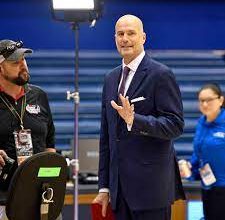The Announcers on ESPN Move Shows The Decline of Men’s ACC Basketball

Over the past few years, a noticeable shift has taken place within the landscape of men’s college basketball, specifically within the Atlantic Coast Conference (ACC). Historically regarded as one of the premier conferences in college hoops, the ACC has seen its dominance slip in recent seasons. Once a conference defined by powerhouse teams, legendary coaches, and NBA-caliber talent, the ACC’s reputation has been increasingly called into question. The last few seasons have raised significant concerns about the direction of ACC men’s basketball, and the trend has been particularly apparent on ESPN broadcasts, where veteran announcers have regularly discussed the perceived decline of the league.
This analysis looks at the factors contributing to this decline, as observed by the experts and commentators on ESPN. While some may argue that the ACC is still a top-tier conference, the undeniable truth is that it no longer commands the same respect and admiration it once did. In fact, ESPN’s announcers, analysts, and color commentators have frequently pointed out the challenges and vulnerabilities that have led to the perceived downfall of ACC men’s basketball.
The Changing Landscape of College Basketball
College basketball, as a whole, has seen a dramatic shift in recent years. New dynamics, such as the rise of the transfer portal, one-and-done players, and NIL (Name, Image, and Likeness) deals, have completely altered the way teams recruit and build their programs. No longer are traditional powerhouses like Duke, North Carolina, and Syracuse automatically able to reload with top-tier recruits year after year. The landscape of college basketball is now far more competitive, with programs from outside the traditional blue bloods rising to prominence.
This disruption has significantly impacted the ACC, as many of the conference’s marquee teams have struggled to maintain the same level of consistency that once defined them. The ACC has had difficulty adapting to these changes, while other conferences, such as the SEC, Big Ten, and Big 12, have managed to capitalize on the shifting dynamics. As a result, the once-feared ACC is no longer as dominant in March Madness, and its power status is increasingly questioned by commentators.
The Decline of Traditional ACC Powerhouses
When discussing the state of ACC men’s basketball, ESPN announcers often point to the fall of the traditional powerhouses that once ruled the college basketball landscape. Duke, North Carolina, and Syracuse have been the focal points of the league for decades, and their struggles have become a microcosm of the conference’s larger issues.
Duke has historically been one of the most successful programs in college basketball. Under legendary coach Mike Krzyzewski, the Blue Devils were a model of excellence, frequently making deep runs in the NCAA Tournament and consistently competing for national titles. However, with Krzyzewski’s retirement following the 2021 season, Duke has experienced a transition period. While Jon Scheyer was selected to replace Krzyzewski, the team’s performance has not been as consistent as it once was. Duke’s struggles with player development, especially in the context of the one-and-done rule, have led to some early exits in the NCAA Tournament and missed opportunities for another championship run. This decline has been discussed in-depth on ESPN broadcasts, with announcers noting that the team’s reliance on short-term talent has hampered their ability to build long-term success.
North Carolina, another staple of the ACC, has faced similar challenges. Despite a storied history, including winning the 2022 NCAA Championship, the Tar Heels have struggled to maintain their elite status. Issues with player consistency, coaching stability, and a lack of elite-level talent have prevented North Carolina from asserting itself as the powerhouse it once was. ESPN announcers frequently point out that, while the Tar Heels have strong recruiting classes, the team’s ability to compete at the highest level on a consistent basis has been compromised. The increased competition in the ACC, combined with struggles in navigating the shifting college basketball landscape, has contributed to North Carolina’s fall from its former perch.
Syracuse, led by Hall of Fame coach Jim Boeheim, has also been a central part of the ACC for years. However, the Orange have seen diminishing returns in recent seasons. Although Boeheim’s zone defense was once considered a tactical innovation that other teams struggled to counter, it has since become easier to exploit. ESPN analysts have pointed out that the lack of versatility in Syracuse’s style of play has hurt their ability to stay competitive in a rapidly evolving college basketball environment. Syracuse’s struggles in recruiting, especially in comparison to other elite programs in the ACC, have further contributed to the team’s decline in national prominence.
The Rise of Other Conferences
While the ACC has experienced a decline in its traditional powers, other conferences have seized the opportunity to elevate their status in men’s basketball. ESPN announcers have frequently noted the rise of the Big Ten, SEC, and Big 12, all of which have seen significant growth in the quality of their basketball programs in recent years.
The Big Ten has been a major competitor to the ACC in terms of overall talent and depth. Teams like Michigan State, Wisconsin, Purdue, and Indiana have been consistently competitive, and the Big Ten’s overall strength has become a talking point for ESPN analysts. The conference has sent multiple teams deep into the NCAA Tournament in recent years, and its physical style of play has posed problems for ACC teams that rely on finesse and skill-based approaches. ESPN’s coverage of Big Ten basketball has shown how this conference has become a viable alternative to the ACC as a premier destination for college basketball.
The SEC, long considered a football-centric conference, has seen a meteoric rise in its men’s basketball programs. Kentucky, Auburn, Alabama, and Arkansas have all become formidable forces in the college basketball landscape. SEC teams have been known for their high-scoring, fast-paced offenses, and their ability to recruit top-tier talent has made them increasingly competitive in the NCAA Tournament. Analysts on ESPN have pointed out that SEC teams now regularly contend with ACC teams for top seeds in March Madness, and their rise has played a role in the weakening of the ACC’s position.
Similarly, the Big 12 has emerged as a powerhouse conference in men’s basketball. Teams like Kansas, Baylor, and Texas Tech have been successful on the national stage, and the conference has consistently been a breeding ground for future NBA talent. ESPN broadcasters have noted that the Big 12’s ability to produce high-level basketball year in and year out has led to a shift in the balance of power. The conference’s competitive balance, with several teams regularly in the national conversation, has made it a difficult conference for the ACC to keep up with.
The Transfer Portal and Recruiting Challenges
One of the most significant changes in college basketball over the past few years has been the advent of the transfer portal. This new landscape has allowed players to transfer from one school to another without sitting out a year, leading to a massive increase in player movement. ESPN announcers have repeatedly discussed how this change has affected traditional powerhouses like the ACC.
For the ACC, the transfer portal has been both a blessing and a curse. While it has allowed programs to plug gaps in their rosters, it has also created instability. In the past, ACC programs could rely on recruiting top-tier high school players to build their rosters. However, with the increasing number of transfers, these teams are often forced to deal with an influx of new players who require more time to gel and develop chemistry.
Moreover, recruiting challenges have become more pronounced in the ACC. The increased focus on NIL deals has allowed other conferences to attract top talent, and the ACC has found it difficult to keep pace. Announcers have noted how the schools in the ACC often fail to match the financial backing and lucrative NIL opportunities that schools in other conferences can offer. As a result, the ACC’s recruiting power has dwindled, with teams unable to land the same caliber of players they once did.
Coaching Instability and Leadership Concerns
The coaching carousel within the ACC has also been a point of concern. While some of the league’s most prominent programs have seen leadership changes, other schools have struggled to find stability at the top. ESPN analysts have pointed out how coaching instability has contributed to a lack of consistency in the ACC’s performance.
While Duke and North Carolina have both maintained solid coaching leadership in recent years, the ACC has seen the exits of other key figures, such as Jim Boeheim at Syracuse, and Leonard Hamilton at Florida State, who is nearing retirement. Coaching turnover at other schools has further compounded the difficulties the ACC has faced in maintaining its former dominance.
Looking Ahead: Can the ACC Recover?
As the NCAA Tournament looms and the regular season winds down, the question remains: can the ACC recover from its decline? ESPN announcers and analysts continue to discuss the conference’s future with a mix of optimism and caution. Programs like Virginia and Miami have shown promise, and coaches such as Tony Bennett (Virginia) and Jim Larranaga (Miami) have demonstrated their ability to build competitive teams. However, there is still a significant gap between the ACC and its peers in terms of overall strength and consistency.
The answer may lie in how the ACC adapts to the evolving college basketball landscape. Recruiting strategies, coaching stability, and how well programs navigate the transfer portal and NIL landscape will determine if the ACC can once again reclaim its place among the elite conferences.
In conclusion, ESPN’s announcers have consistently emphasized the shifting dynamics of men’s ACC basketball. The conference’s once-unassailable dominance has given way to uncertainty and competitiveness from other leagues. For the ACC to reassert itself, it will need to overcome several obstacles, including recruiting challenges, coaching transitions, and adapting to the new realities of modern college basketball. The coming years will be critical in determining whether the ACC can rediscover its former glory or if the once-mighty conference will remain in decline.









